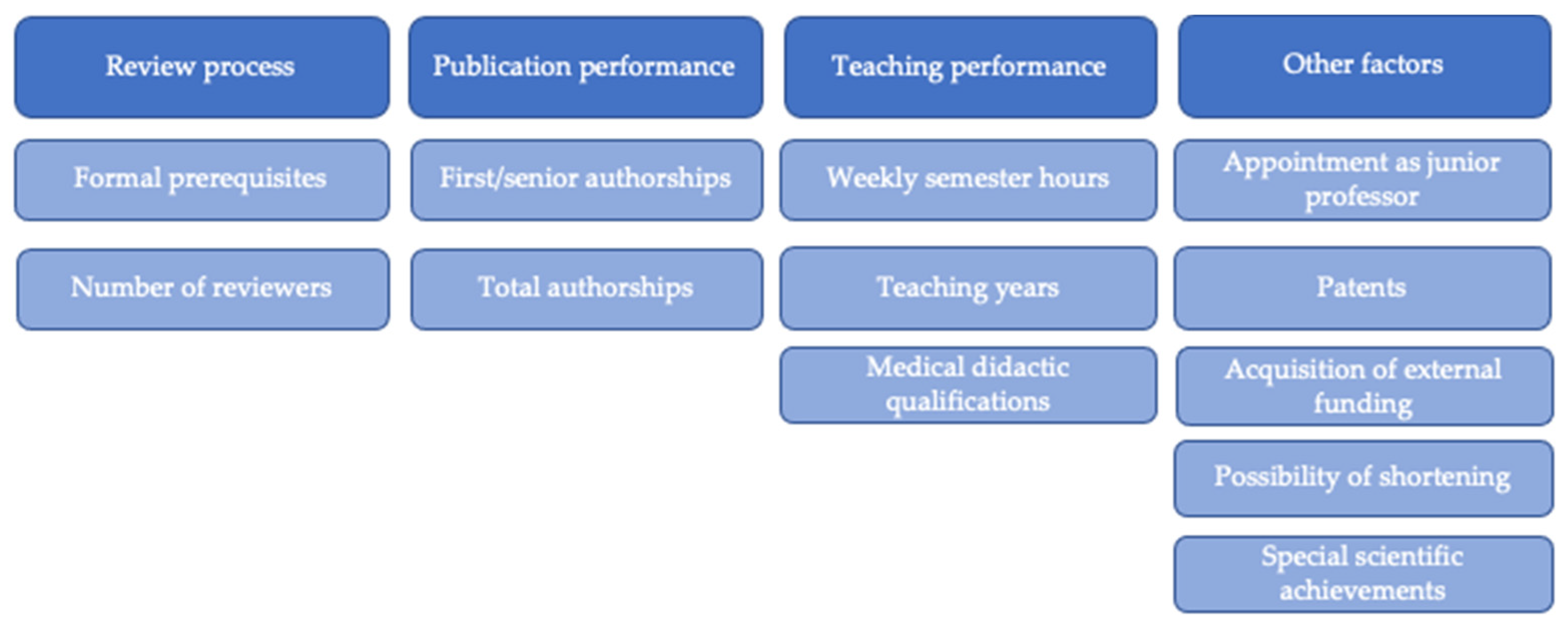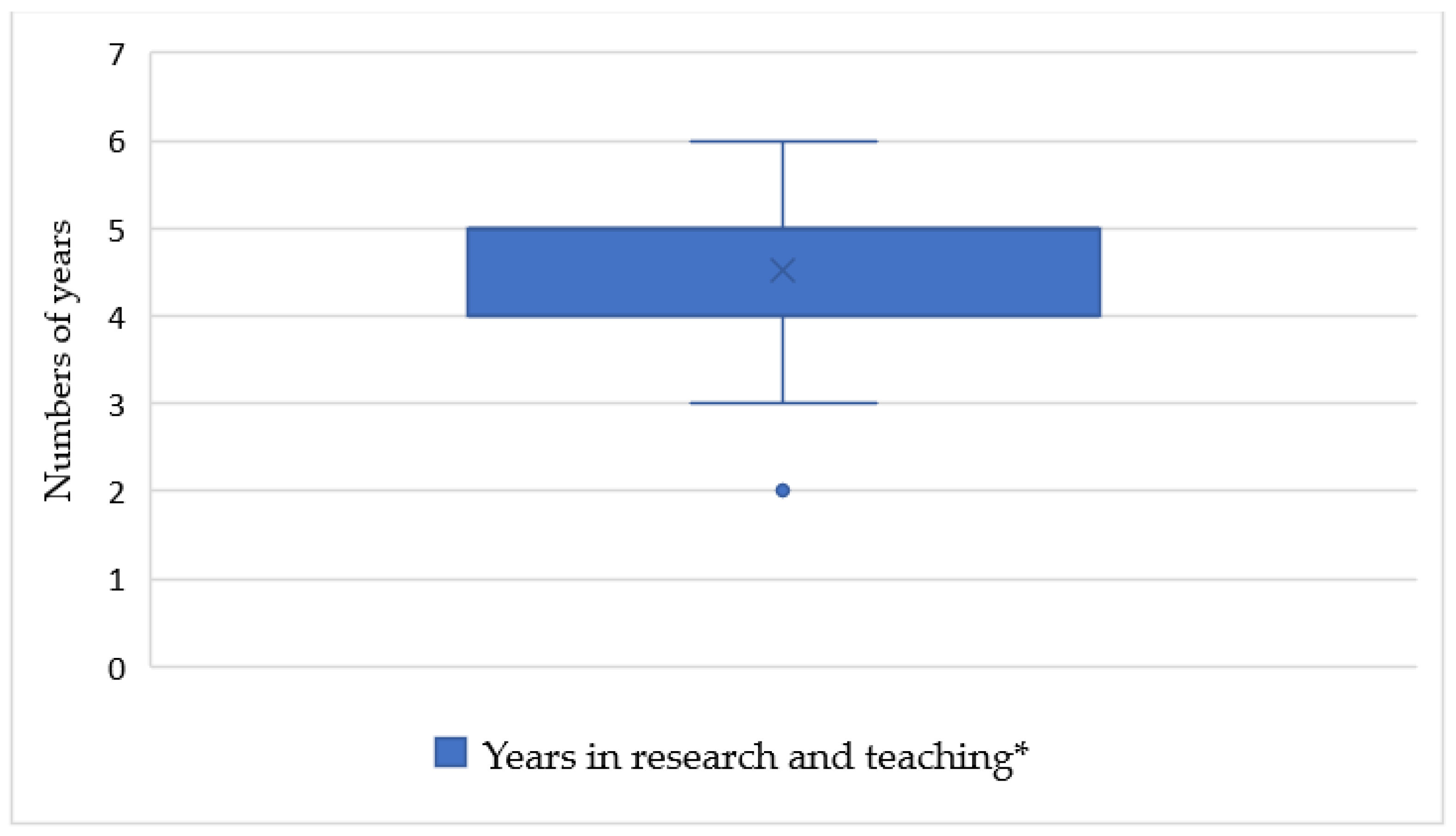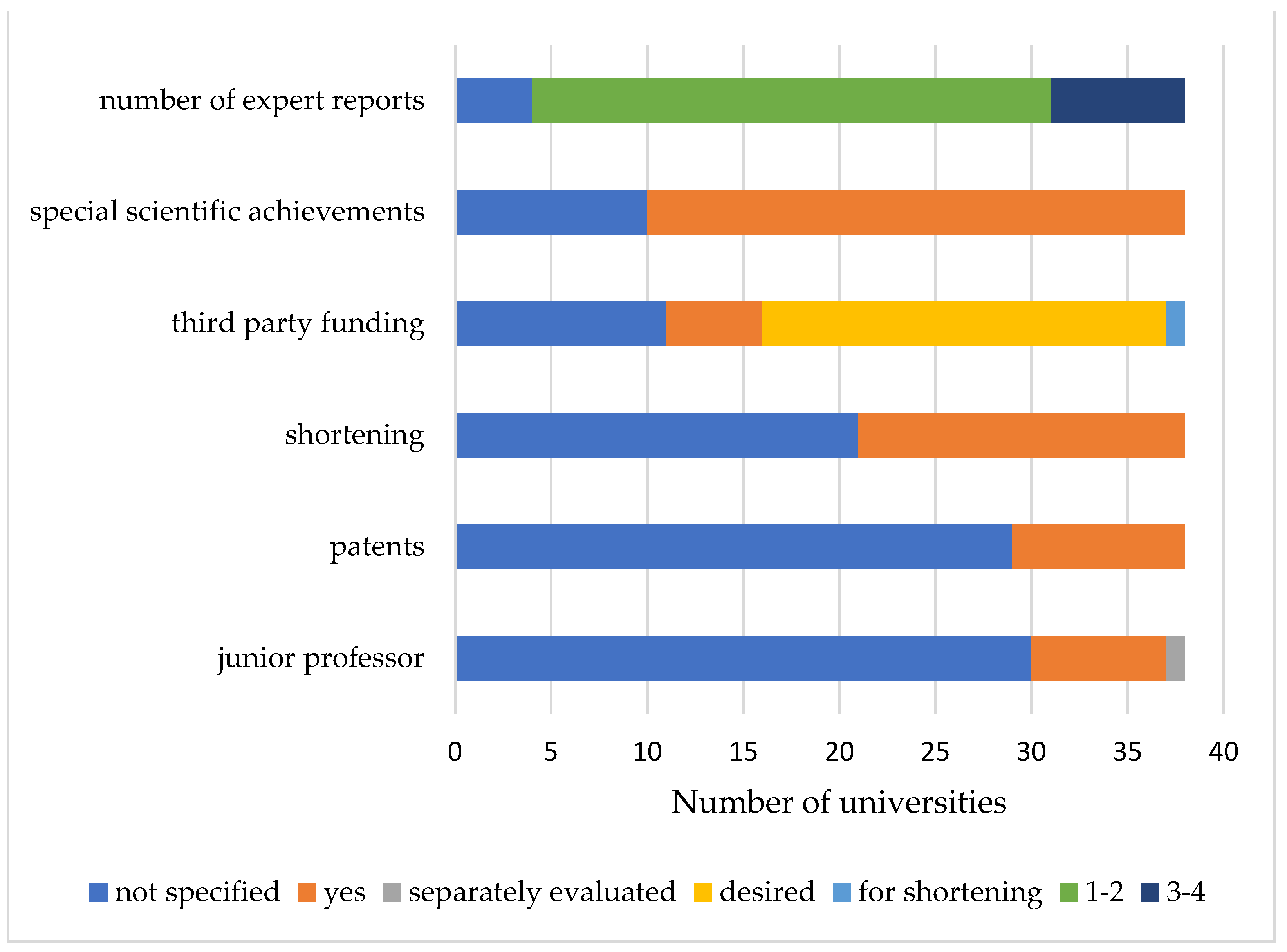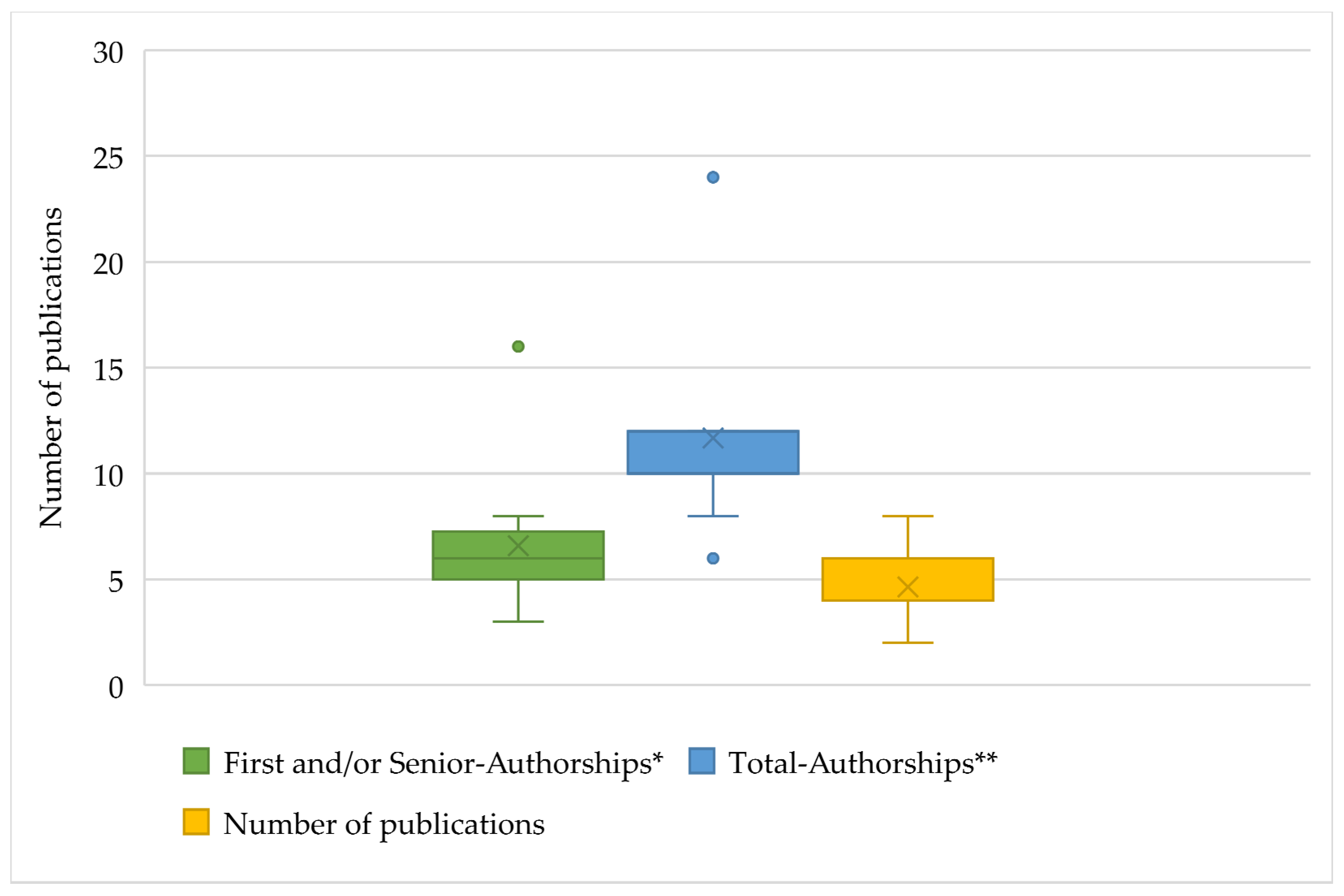Requirements for Becoming an Adjunct Professor in Medicine: A Comparative Analysis of the Regulations of German Medical Faculties
Abstract
:1. Introduction
2. Methods
2.1. German System
2.2. Study Design
2.3. Inclusion Criteria
2.4. Exclusion Criteria
2.5. Target Criteria
2.6. Goal of Analysis
2.7. Statistical Analysis
3. Results
3.1. Basic Requirements
3.2. Research Performance
3.3. Performance in Teaching
3.4. Assessment
3.5. Further Criteria
4. Discussion
5. Conclusions
Supplementary Materials
Author Contributions
Funding
Institutional Review Board Statement
Informed Consent Statement
Data Availability Statement
Conflicts of Interest
References
- Sorg, H.C.; Betzler, C.; Grieswald, C.G.; Schwab, D.; Tilkorn, J.; Hauser, J. Postdoctoral lecturer thesis in medicine: Academic competence or career booster? Chirurg 2016, 87, 520–527. [Google Scholar] [CrossRef] [PubMed]
- Alawi, S.A.; Luketina, R.; Krezdorn, N.; Busch, L.F.; Limbourg, A.; Branski, L.; Vogt, P.M.; Jokuszies, A. How to become a medical professor—A comparative analysis of academic requirements in germany and the united states. Innov. Surg. Sci. 2019, 4, 108–115. [Google Scholar] [CrossRef] [PubMed] [Green Version]
- Pabst, R.; Strate, J. Major differences in procedure in receiving the academic title ausserplanmaessiger professor. Criteria and evaluation of research and teaching at german medical schools. Chirurg 2000, 71, 106–108. [Google Scholar] [CrossRef] [PubMed]
- Sorg, H.; Knobloch, K. Quantitative evaluation of the requirements for the promotion as associate professor at german medical faculties. GMS Z. Med. Ausbild. 2012, 29, Doc69. [Google Scholar] [CrossRef] [PubMed]
- Breithaupt, H. A focus on the individual. Germany has begun to reform its university system to make it more attractive to both foreign and german scientists and students. EMBO Rep. 2005, 6, 16–19. [Google Scholar] [CrossRef] [PubMed]
- Weineck, S.B.; Koelblinger, D.; Kiesslich, T. Medical habilitation in german-speaking countries: Quantitative assessment of content and elaboration of habilitation guidelines. Chirurg 2015, 86, 355–365. [Google Scholar] [CrossRef] [PubMed]
- Burkhardt, A.; Nickel, S.; Berndt, S.; Püttmann, V.; Rathmann, A. Die juniorprofessur–vergleichende analyse neuer und traditioneller karrierewege im deutschen wissenschaftssystem. Beiträge Hochschulforschung 2016, 38, 86–117. [Google Scholar]
- Pantenburg, B.; Kitze, K.; Luppa, M.; König, H.H.; Riedel-Heller, S.G. Physician emigration from germany: Insights from a survey in saxony, germany. BMC Health Serv. Res. 2018, 18, 1–10. [Google Scholar] [CrossRef] [PubMed] [Green Version]
- Fontane, B.M.S.T. Regulation Adjunct Professorship University of Brandenburg Medical School Theodor Fontane. Available online: https://www.mhb-fontane.de/files/Dateien/Aktuelles/2020/leitfaden-zur-ordnung-apl-professur.pdf (accessed on 9 October 2021).
- Goethe University Frankfurt am Main. Regulation Adjunct Professorship Goethe University Frankfurt am Main. Available online: https://www.uni-frankfurt.de/60680035/apl_kriterien_2015.pdf (accessed on 9 October 2021).
- Johannes-Gutenberg-University Mainz. Regulation Adjunct Professorship Johannes-Gutenberg-University Mainz. Available online: https://www.um-mainz.de/typo3temp/secure_downloads/23522/0/26722321471205584adc6541398ed12ddd6256f5/Informationsblatt_zur_Ernennung_zum_apl-Professor.pdf (accessed on 9 October 2021).
- University Leipzig. Regulation Adjunct Professorship University Leipzig. Available online: https://www.uniklinikum-leipzig.de/Documents/Medizinische%20Fakultät/Referat%20Akadem.%20Angelegenheiten/APL-Richtlinien-MF-Novellierung__FRS%2024.10.2017_final.pdf (accessed on 9 October 2021).
- Philipps-University Marburg. Regulation Adjunct Professorship Philipps-University Marburg. Available online: https://www.uni-marburg.de/de/universitaet/administration/amtliche-mitteilungen/jahrgang2016/39_2016.pdf (accessed on 9 October 2021).
- University Ulm. Regulation Adjunct Professorship University Ulm. Available online: https://www.uni-ulm.de/fileadmin/website_uni_ulm/med/03_Laufbahn_und_Karriere/01_Akademische_Angelegenheiten/Habilitation/APL-Richtlinien_2021.pdf (accessed on 9 October 2021).
- University Witten/Herdecke. Regulation Adjunct Professorship University Witten/Herdecke. Available online: https://www.uni-wh.de/fileadmin/user_upload/03_G/01_Profil/Ausfuehrungsbestimmungen_der_APL-Kommission_20.04.2016.pdf (accessed on 9 October 2021).
- Ruhr-University Bochum. Regulation Adjunct Professorship Ruhr-University Bochum. Available online: https://www.medizin.ruhr-uni-bochum.de/dekanat/sachgebiete_service/apl.html.de (accessed on 9 October 2021).
- University Rostock. Regulation Adjunct Professorship University Rostock. Available online: https://www.med.uni-rostock.de/forschung-lehre/medizinische-fakultaet/ordnungen-richtlinien/verfahrensordnung-apl-professur-und-honorarprofessur (accessed on 9 October 2021).
- Carl von Ossietzky University Oldenburg. Regulation Adjunct Professorship Carl von Ossietzky University Oldenburg. Available online: https://uol.de/f/6/APL/Empfehlungen_Apl._FKVI_03082017.pdf (accessed on 9 October 2021).
- Heinrich-Heine-University Düsseldorf. Regulation Adjunct Professorship Heinrich-Heine-University Düsseldorf. Available online: https://www.medizin.hhu.de/akademische-karriere/apl-professuren/das-apl-verfahren (accessed on 9 October 2021).
- University Regensburg. Regensburg, Bavaria, Germany. Regulation adjunct professorship university regensburg. Unpublished work.
- Technical University of Munich. Regulation Adjunct Professorship Technical University of Munich. Available online: https://www.med.tum.de/de/außerplanmäßige-professur (accessed on 9 October 2021).
- Georg-August-University Göttingen. Regulation Adjunct Professorship Georg-August-University Göttingen. Available online: https://www.uni-goettingen.de/de/honorar-+/apl.+professoren+/304462.html (accessed on 9 October 2021).
- Kaplan, K. Academia: The changing face of tenure. Nature 2010, 468, 123–125. [Google Scholar] [CrossRef] [PubMed]
- Science Council. Recommendations on Career Goals and Paths at Universities. Available online: https://www.wissenschaftsrat.de/download/archiv/4009-14.html (accessed on 9 August 2021).
- Federal Ministry of Education and Research. The Tenure Track Program. Available online: https://www.tenuretrack.de/de/tenure-track-programm/die-tenure-track-professur. (accessed on 9 August 2021).
- Nagelschmidt, M.; Bergdolt, K.; Troidl, H. Evaluation of qualification regulations for medical faculties of german universities and recommendations for standardization. Chirurg 1998, 69, 481–489. [Google Scholar] [CrossRef] [PubMed]
- Strauss, M.; Ehlers, J.; Gerss, J.; Klotz, L.; Reinecke, H.; Leischik, R. Status quo—The requirements for medical habilitation in germany. Dtsch. Med. Wochenschr. 2020, 145, e130–e136. [Google Scholar] [PubMed]
- German Research Foundation. Recommendations for a Performance-Oriented Allocation of Funds (Lom) at the Medical Faculties. Available online: https://www.dfg.de/download/pdf/dfg_im_profil/reden_stellungnahmen/2004/stellungnahme_klinische_forschung_04.pdf (accessed on 23 June 2021).
- Bauer, B. Habilitationskriterium impact factor–wie evaluieren medizinische fakultäten wissenschaftliche leistungen von habilitanden? Med. Bibl. Inf. 2003, 3, 40–43. [Google Scholar]
- Baethge, C. Impact factor—A useful tool, but not for all purposes. Dtsch. Arztebl. Int. 2012, 109, 267. [Google Scholar] [PubMed]
- Herrmann-Lingen, C.; Brunner, E.; Hildenbrand, S.; Loew, T.H.; Raupach, T.; Spies, C.; Treede, R.D.; Vahl, C.F.; Wenz, H.J. Evaluation of medical research performance—Position paper of the association of the scientific medical societies in germany (awmf). Ger. Med. Sci. 2014, 12, Doc11. [Google Scholar] [PubMed]
- Sorg, H.; Kramer, R.; Grieswald, C.; Schwab, C.G.; Thonnes, S.; Reinke, J.M.; Hauser, J.; Tilkorn, D.J. Assessment of the significance and the requirements of medical postdoctoral lecture qualifications in germany by the assessment committees. Z Evid Qual. Gesundhwes 2016, 115, 71–77. [Google Scholar] [CrossRef] [PubMed]
- Federal Statistical Office. Personnel at Universities 2019. Available online: https://www.destatis.de/DE/Themen/Gesellschaft-Umwelt/Bildung-Forschung-Kultur/Hochschulen/Publikationen/Downloads-Hochschulen/personal-hochschulen-2110440197004.pdf?__blob=publicationFile (accessed on 23 June 2021).
- Federal Statistical Office. Press Release no. 217, Proportion of Women among Habilitated Continues to Rise Steadily. Available online: https://www.destatis.de/DE/Presse/Pressemitteilungen/2017/06/PD17_217_213.html (accessed on 23 June 2021).




| Value Details | % | Number |
|---|---|---|
| I. and II. Quartile of area of expertise * | 3% | 1 |
| >5 times the IF of respective area of expertise ** | 3% | 1 |
| IF of at least 10 *** | 3% | 1 |
| IF > 40 since habilitation **** | 3% | 1 |
| 12 times median ***** | 6% | 2 |
| Detailed consideration ****** | 32% | 10 |
Publisher’s Note: MDPI stays neutral with regard to jurisdictional claims in published maps and institutional affiliations. |
© 2021 by the authors. Licensee MDPI, Basel, Switzerland. This article is an open access article distributed under the terms and conditions of the Creative Commons Attribution (CC BY) license (https://creativecommons.org/licenses/by/4.0/).
Share and Cite
Altenberger, S.; Leischik, R.; Vollenberg, R.; Jehn, U.; Reinecke, H.; Ehlers, J.P.; Strauss, M. Requirements for Becoming an Adjunct Professor in Medicine: A Comparative Analysis of the Regulations of German Medical Faculties. Int. J. Environ. Res. Public Health 2021, 18, 11856. https://doi.org/10.3390/ijerph182211856
Altenberger S, Leischik R, Vollenberg R, Jehn U, Reinecke H, Ehlers JP, Strauss M. Requirements for Becoming an Adjunct Professor in Medicine: A Comparative Analysis of the Regulations of German Medical Faculties. International Journal of Environmental Research and Public Health. 2021; 18(22):11856. https://doi.org/10.3390/ijerph182211856
Chicago/Turabian StyleAltenberger, Sarah, Roman Leischik, Richard Vollenberg, Ulrich Jehn, Holger Reinecke, Jan Peter Ehlers, and Markus Strauss. 2021. "Requirements for Becoming an Adjunct Professor in Medicine: A Comparative Analysis of the Regulations of German Medical Faculties" International Journal of Environmental Research and Public Health 18, no. 22: 11856. https://doi.org/10.3390/ijerph182211856
APA StyleAltenberger, S., Leischik, R., Vollenberg, R., Jehn, U., Reinecke, H., Ehlers, J. P., & Strauss, M. (2021). Requirements for Becoming an Adjunct Professor in Medicine: A Comparative Analysis of the Regulations of German Medical Faculties. International Journal of Environmental Research and Public Health, 18(22), 11856. https://doi.org/10.3390/ijerph182211856







